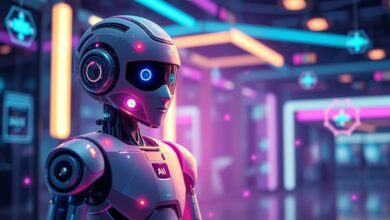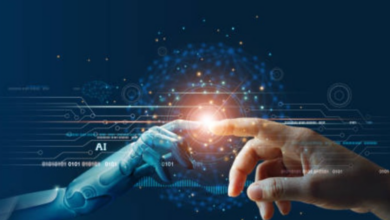Deep reinforcement learning remains at the very front of state-of-the-art man-made reasoning, mixing the domains of profound learning and supporting figuring out how to empower machines to independently learn and simply decide.
Deep reinforcement learning (DRL) includes preparing calculations to connect with a climate and gaining from criticism as remunerations or punishments. This strong procedure joins the emblematic force of profound brain networks with the dynamic capacities of support learning specialists.
DRL has gathered enormous consideration because of its striking skill in handling complex assignments across different spaces, from gaming and mechanical technology to back and medical services. Its flexibility and viability make it a foundation in the domain of computer-based intelligence examination and application, promising extraordinary effects across ventures and teachers.
As we dive further into the complexities of deep reinforcement learning, we should uncover its approach and disentangle its true capacity for changing how machines see and collaborate with their general surroundings.
Fundamentals of Reinforcement Learning
Setting out on the excursion of seeing deep reinforcement learning requires a strong handle on the essentials of support learning. At its center, RL is a worldview of AI worried about how specialists figure out how to settle on successive choices in a climate to boost combined rewards.
Inside the domain of support learning, a few vital parts and ideas assume essential parts in forming the growing experience. We should dig into these angles to disentangle the pith of the RL approach:
Read Also: The Rise of AI: Transforming Business and Daily Life
Basic Concepts and Terminology
To understand deep reinforcement learning, one must initially accept the essential ideas and wording intrinsic to support learning. These incorporate thoughts like state, activity, prize, and strategy, which structure the structure blocks of RL calculations.
Components of Reinforcement Learning
In the scene of deep reinforcement learning, understanding the basic parts of support learning is vital. Support learning contains a few key components that shape how specialists connect with their current circumstances and learn ideal systems after some time.
These parts, including the specialist, climate, activities, and prizes, structure the structure blocks of support learning frameworks. By appreciating these essential components, we can acquire knowledge of how deep reinforcement learning calculations capability and how they are applied to take care of mind-boggling dynamic issues.
Agent
The agent in reinforcement learning alludes to the substance answerable for simply deciding and connecting with the climate. It figures out how to explore the climate in light of previous encounters and criticism through remunerations or punishments.
Environment
The environment typifies the outer framework with which the specialist collaborates. It gives criticism to the specialist as the state advances and rewards, forming the growing experience.
Actions
Actions represent the decisions accessible to the specialist at every choice point. The specialist chooses activities because of their present status and the ideal result, meaning to boost combined awards over the long haul.
Rewards
Rewards act as the input instrument for the agent, demonstrating the attractiveness of its activities. Positive prizes build up wanted ways of behaving, while negative prizes put unfortunate activities down.
Markov Decision Processes (MDPs)
Markov Decision Processes (MDPs) give a conventional structure to demonstrating successive dynamic issues in reinforcement learning. They comprise of states, activities, change probabilities, and prizes, exemplifying the elements of the climate in a probabilistic way.
Understanding Deep Learning
Leaving on the excursion of seeing deep reinforcement learning involves diving into the domain of profound learning, a basic part that enables calculations to separate complex examples and portrayals from the information. Deep learning fills in as the foundation of many best-in-class approaches in man-made reasoning, giving the ability to machines to learn complicated connections and go with refined choices.
Basics of Neural Networks
To fathom the substance of deep reinforcement learning, one must initially get a handle on the rudiments of brain organization. Brain networks impersonate the construction and capability of the human mind, involving interconnected layers of neurons that cycle and change input information. These organizations are adroit at learning progressive portrayals, empowering them to catch many-sided examples and elements inside complex datasets.
Deep Learning Architectures
In the domain of deep reinforcement learning, understanding the complexities of profound learning structures is principal. Profound learning structures act as the foundation of many high-level calculations, engaging specialists to gain complex examples and portrayals from information.
By investigating these structures, we can disentangle the components that empower specialists to process and decipher data, working with astute dynamics in unique conditions.
Convolutional Neural Networks (CNNs)
Convolutional Neural Networks (CNNs) have some expertise in handling network-like information, like pictures and recordings. They influence convolutional layers to remove spatial elements progressively, empowering them to perform cutting-edge assignments like picture order, object recognition, and division.
Recurrent Neural Networks (RNNs)
Recurrent Neural Networks (RNNs) succeed in taking care of successive information with transient conditions, like time series and regular language. They have intermittent associations that permit them to keep up with memory across time steps, making them appropriate for errands like language displaying, machine interpretation, and discourse acknowledgment.
Deep Q-Networks (DQNs)
Deep Q-Networks (DQNs) address a specific engineering for support picking up, and consolidating profound brain networks with Q-learning calculations. These organizations figure out how to rough the activity esteem capability, empowering them to settle on ideal choices in conditions with high-layered state spaces.
Training Neural Networks
Training neural networks is a basic part of deep reinforcement learning, significant in empowering specialists to gain as a matter of fact, and further develop their dynamic capacities. Neural networks are prepared to utilize calculations, for example, backpropagation and slope plummet, which change the organization’s boundaries to limit expectation blunders.
All through the preparation cycle, information is taken care of in the organization, and the model iteratively figures out how to make more precise forecasts. By iteratively refreshing the organization’s boundaries given noticed blunders, brain networks steadily work on their presentation of the given errand. This iterative course of improvement assumes a focal part in deep reinforcement learning, enabling specialists to adjust and streamline their systems over the long run.
Backpropagation
Backpropagation fills in as the foundation of preparing brain organizations, empowering them to gain from information by iteratively changing their boundaries to limit expectation mistakes. This calculation figures slopes of the misfortune capability for network boundaries, working with productive enhancement through inclination plunge.
Gradient Descent
Gradient descent lies at the core of enhancing brain network boundaries, directing the educational experience toward the minima of the misfortune capability. By iteratively refreshing boundaries toward the steepest plummet, angle plunge calculations empower brain organizations to join to ideal arrangements.
Read Also: Deep Learning vs Machine Learning: Key Differences
Integration of Reinforcement Learning and Deep Learning
Coordinating reinforcement learning with deep learning addresses an essential progression in the domain of man-made consciousness, synergistically utilizing the qualities of the two ideal models to handle complex dynamic undertakings with exceptional viability.
Consistent combination of deep learning and support learning strategies, revealing insight into the inspirations driving their joining, the difficulties presented by customary support learning draws near, and the groundbreaking advantages given by the fuse of profound learning methods.
Motivation for Deep Reinforcement Learning
The joining of deep reinforcement learning is propelled by the mission for more versatile, adaptable, and effective ways to deal with learning ideal arrangements in complex conditions. Conventional reinforcement learning calculations frequently battle with high-layered state spaces and meager prizes, thwarting their appropriateness to genuine issues.
Deep learning offers an answer by enriching reinforcement learning specialists with the capacity to gain progressive portrayals from crude tactile information sources, empowering them to extricate remarkable elements and examples fundamental to navigation.
Challenges of Traditional Reinforcement Learning
Traditional reinforcement learning faces a heap of difficulties, including test failure, non-direct and high-layered state spaces, and the scourge of dimensionality. In addition, some certifiable applications present meager and postponed rewards, making it trying for customary RL calculations to learn powerful arrangements. These impediments require the incorporation of profound learning methods to conquer the intrinsic limitations of Traditional reinforcement learning draws near.
Benefits of Deep Learning in Reinforcement Learning
The consolidation of deep learning in reinforcement learning presents various advantages, reforming the field and empowering forward leaps in different areas.
Deep neural networks empower reinforcement learning specialists to effectively gain complex mappings from crude tangible contributions to activity arrangements, bypassing the requirement for manual element designing.
Besides, profound learning methods work with the speculation of learned approaches across assorted conditions, upgrading the adaptability and strength of reinforcement learning algorithms.
Methodology of Deep Reinforcement Learning
Digging into the philosophy of deep reinforcement learning uncovers a rich scene of systems and procedures pointed toward preparing specialists to settle on ideal choices in complex conditions.
By understanding these procedures, professionals gain experiences into the components basic the growing experience, engaging them to plan more productive and successful reinforcement learning algorithms.
A. Model-Free vs. Model-Based Reinforcement Learning
In deep reinforcement learning, the decision between sans model and model-based approaches generally shapes the educational experience. Without model strategies straightforwardly gain the ideal strategy as a matter of fact, bypassing the requirement for an unequivocal model of the climate.
On the other hand, model-based techniques include learning a model of the climate’s elements and utilizing it to design future activities. Each approach enjoys its benefits and compromises, without model strategies succeeding in adaptability and versatility, while model-based techniques offer better examples of effectiveness and speculation.
Exploration vs. Exploitation Tradeoff
The investigation double-dealing tradeoff lies at the core of reinforcement learning, directing how specialists balance between evaluating new activities to find possibly better strategies (investigation) and taking advantage of known information to augment quick rewards (abuse).
Deep reinforcement learning calculations should work out some kind of harmony between investigation and abuse to learn ideal strategies in complex conditions. Different investigation procedures, like epsilon-avaricious, softmax, and Thompson testing, are utilized to explore this tradeoff and guide the learning process.
Policy Gradient Methods
Strategy slope techniques address a class of reinforcement learning calculations that straightforwardly streamline the arrangement boundaries to expand anticipated rewards. These strategies define the strategy as a neural network and utilize slope rising to refresh the organization loads because of the angles of anticipated compensations for the approach boundaries.
Strategy angle techniques offer a few benefits, including the capacity to deal with nonstop activity spaces and stochastic strategies, making them appropriate for complex undertakings in deep reinforcement learning.
Value Function Methods
Esteem capability techniques intend to gauge the worth of states or state-activity matches, giving experiences into the normal return under a given strategy. Deep reinforcement learning calculations frequently utilize esteem capability approximators, for example, deep Q-networks (DQNs), to gain the ideal worth capability.
By utilizing deep neural networks, esteem capability techniques can inexact complex worth capabilities and work with proficient approach improvement and navigation.
Actor-Critic Methods
Actor-critic methods consolidate the benefits of both strategy slope and worth capability techniques, utilizing separate entertainer and pundit organizations to get familiar with the arrangement and worth capability simultaneously.
The actor-network learns the policy parameters, while the critic network estimates the value function to provide feedback on the quality of actions.
This architecture enables actor-critic methods to achieve a balance between stability and efficiency, making them widely used in deep reinforcement learning research and applications.
Deep Reinforcement Learning Algorithms
Digging into the domain of reinforcement learning algorithms uncovers a different scene of systems pointed toward empowering specialists to independently learn and adjust to complex conditions. These calculations tackle the force of profound brain organizations to instill reinforcement learning agents with the ability to explore mind-boggling choice spaces and improve their ways of behaving after some time.
Deep Q-Networks (DQN)
Deep Q-Networks (DQN) address an original headway in deep reinforcement learning, presenting a mix of deep neural networks with Q-learning calculations. By approximating the activity esteem capability utilizing brain organizations, DQNs empower specialists to gain ideal arrangements from high-layered state spaces, making them ready for leap forwards in areas like gaming and robotics.
Deep Deterministic Policy Gradient (DDPG)
Deep Deterministic Policy Gradient (DDPG) calculations broaden the standards of entertainer pundit techniques to constant activity spaces, empowering specialists to learn deterministic approaches through slope climb. By consolidating profound brain networks with the deterministic strategy slope calculation, DDPG works with the learning of mind-boggling control arrangements in undertakings like mechanical control and independent driving.
Proximal Policy Optimization (PPO)
Proximal Policy Optimization (PPO) calculations offer a principled way to deal with streamlining strategy boundaries through trust district imperatives, guaranteeing steady and productive arrangement refreshes. By iteratively advancing arrangement boundaries utilizing stochastic angle rising, PPO calculations accomplish cutting-edge execution in different support learning benchmarks, exhibiting heartiness and versatility across assorted conditions.
Trust Region Policy Optimization (TRPO)
Trust Region Policy Optimization (TRPO) calculations focus on steadiness and test productivity by obliging arrangement refreshes inside a trust district, moderating the gamble of huge strategy deviations.
By leveraging trust region constraints to guide policy updates, TRPO algorithms exhibit enhanced convergence properties and robustness to hyperparameter variations, making them well-suited for real-world reinforcement learning applications.
Asynchronous Advantage Actor-Critic (A3C)
Asynchronous Advantage Actor-Critic (A3C) calculations utilize nonconcurrent preparing cycles to speed up learning and further develop test effectiveness in reinforcement learning undertakings. By utilizing different equal entertainers connecting with the climate nonconcurrently, A3C calculations work with more assorted investigation and empower specialists to learn powerful arrangements in complicated and dynamic conditions.
Conclusion
All in all, the strategy of deep reinforcement learning exemplifies a multi-layered way to deal with empowering machines to learn and pursue choices independently in complex conditions. All through this investigation, we’ve dove into the essentials of reinforcement learning, the coordination of profound learning procedures, and the different exhibits of calculations driving headways in the field.
By understanding the center standards and strategies, we gain knowledge of the significance of deep reinforcement learning in handling certifiable difficulties across different spaces, from advanced mechanics and gaming to medical care and money. As we plan, the potential open doors for additional advancement and improvement in deep reinforcement learning are unlimited.
With continuous examination and progressions, we can expect considerably more refined calculations, improved adaptability, and more extensive pertinence in different settings. To remain refreshed on the most recent turns of events and join the discussion, go ahead and share your considerations and criticism in the remarks below.
Remember to impart this significant data to your companions and partners, enabling others to investigate the interesting universe of deep reinforcement learning. Together, we can drive progress and open the maximum capacity of Artificial intelligence.








